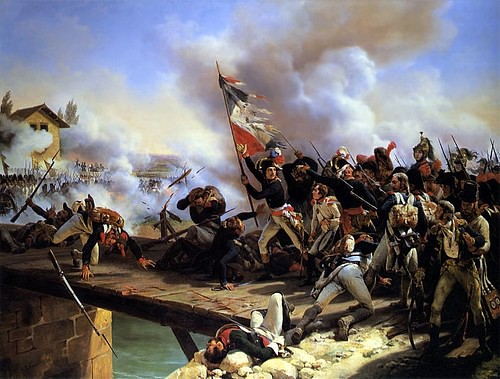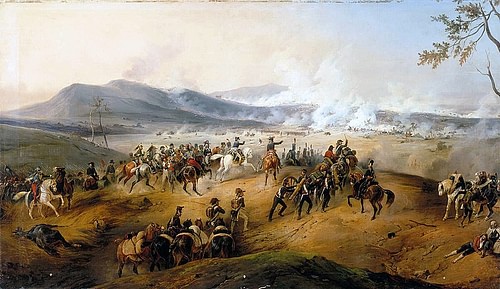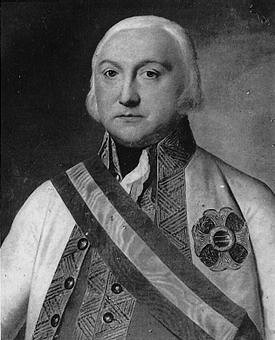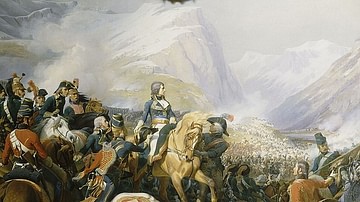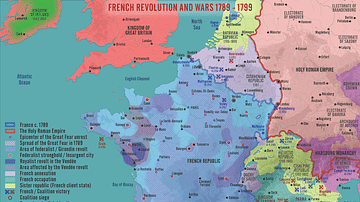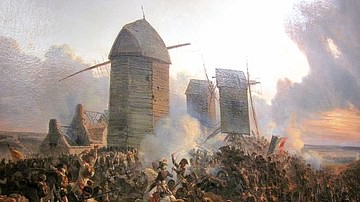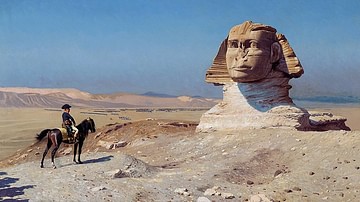The Battle of Arcole (15-17 November 1796), or Arcola, was a three-day battle fought between Napoleon Bonaparte's French Army of Italy and an Austrian army under József Alvinczi. Part of Napoleon's Italian Campaign, the battle foiled Austria's third attempt to relieve the siege of Mantua and helped lead to France's success in the broader War of the First Coalition (1792-1797).
The battle, which involved a daring attempt by General Bonaparte to outflank the Austrian army, was mostly centered around the bridge at Arcole, about 25 kilometers (16 mi) southeast of Verona. It was a hard-fought clash that included such dramatic moments as Bonaparte personally leading a charge across the bridge, and it ultimately ended in a French victory.
The Key to Italy
In October 1796, the siege of Mantua entered its fourth month. Situated in the Lombardy region of northern Italy, Mantua was one of four crucial fortresses collectively known as the Quadrilateral, that guarded the Alpine passes and the entrances to the Po River and Lake Garda (the other three fortresses being Peschiera, Legnago, and Verona). As such, Mantua held the key to Austria's control of northern Italy, making it vital that the French Republic capture it.
The siege was being carried out by the 41,400 men of the French Army of Italy, commanded by the 27-year-old General Napoleon Bonaparte. Since the siege had begun in June, Bonaparte had already fended off two Austrian attempts to relieve it. The first had come in late July when a 50,000-man Austrian army led by Field Marshal Dagobert von Wurmser advanced down Lake Garda. Wurmser had divided his army into two corps, each one marching down an opposite side of the lake; Bonaparte, therefore, was able to defeat each corps before they had a chance to link up, beating the first at the Battle of Lonato (3 August) and the other at the Battle of Castiglione (5 August).
Wurmser retreated north to Tyrol to regroup and launched a second attempt to relieve the siege at the end of August. This, too, ended in failure when Wurmser was again defeated by Bonaparte at the First Battle of Bassano (8 September). Rather than cutting his losses and retreating after this defeat, Wurmser elected instead to press on to Mantua. The French pursued, and after a hard-fought battle outside the city on 15 September, Wurmser was forced behind Mantua's walls alongside 14,000 of his men. The French then resumed their siege of Mantua, with Wurmser's army now trapped inside.
Far from alleviating the suffering of the 16,000-man Mantua garrison, Wurmser's presence had only made things worse. Mantua's resources, which were already depleted, now buckled under the strain of 14,000 additional mouths to feed, as the overcrowded garrison accelerated the spread of disease. Within six weeks of Wurmser's defeat, 4,000 Austrians had died of wounds, disease, or malnutrition, and a further 7,000 were hospitalized. By 10 October, there was only 38 days' worth of food left, forcing Wurmser to launch increasingly desperate sorties to forage for supplies; one such sortie cost 1,000 Austrian casualties. On 16 October, Bonaparte called on Wurmser to surrender, telling him that "the brave should be facing danger, not swamp plague" (Roberts, 118). Wurmser refused.
The Austrian Counterattack
Fortunately for the dying Mantua garrison, help was on the way. The Aulic Council, the bureaucratic committee that oversaw Austria's military affairs, had authorized a third relief attempt. Command of a reconstituted army of 46,000 men was given to the Hungarian General József Alvinczi, an experienced soldier who had recently fought the French in Flanders and on the Rhine. Alvinczi planned to launch a double-pronged attack: the 19,000-man Tyrol Corps, led by General Paul Davidovich, was to move south from the Alps to strike at Trento. This was a diversionary attack to allow the 28,000-man Friaul Corps, led by Alvinczi himself, time to cross the Piave River and move west toward Mantua. The hope was that Wurmser would break free of Mantua during the fighting and strike the French in the rear.
On 1 November, the Austrian offensive got underway; Alvinczi began crossing the Piave while Davidovich descended on Trento. Bonaparte reacted immediately, gathering the bulk of his army near Verona to fend off Alvinczi but sending only a single division under General Claude Vaubois to meet Davidovich. Thus, Bonaparte fell for the Austrian trap; the Austrians had gone to great lengths to conceal the size of Davidovich's corps. On 2 November, Vaubois attacked Davidovich near Cembra, only to pull back toward Calliano after realizing he was vastly outnumbered. Upon receiving Vaubois's report on 5 November, Bonaparte modified his plan, ordering Vaubois to hold his ground at Calliano to give the rest of the army time to beat Alvinczi.
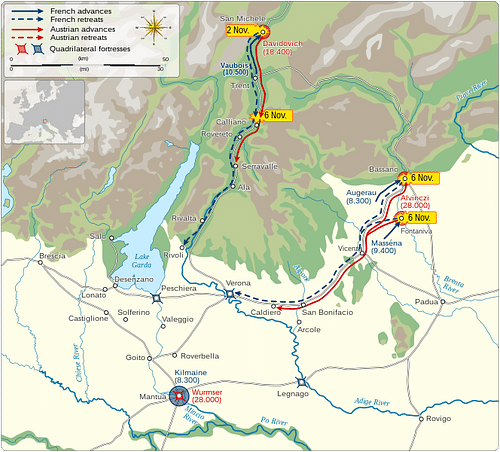
On 6 November, Bonaparte attacked the vanguard of the Friaul Corps as it crossed the Brenta River at Bassano. The French were unable to force the Austrians back across the river and, after suffering 3,000 losses, Bonaparte had no choice but to withdraw. The Second Battle of Bassano marked Bonaparte's first defeat, though it was a minor one. The French pulled back to Vicenza, where Bonaparte received more bad news: Vaubois had been completely routed on 4 November, having lost around 4,400 men. Although Vaubois had managed to rally his shaken troops near Rivoli, his retreat allowed Davidovich to capture Trento and Rovereto. Bonaparte was forced to pull two divisions back to a more centralized position; enraged, he traveled to Rivoli on 7 November where he publicly berated Vaubois's men for their failure:
Soldiers, I am not satisfied with you. You have shown neither bravery, discipline, nor perseverance…You have allowed yourselves to be driven from positions where a handful of men could have stopped an army. Soldiers of the 39th and 85th, you are not French soldiers. General Chief-of-Staff, let it be inscribed on their colors: "they no longer form part of the Army of Italy!" (Chandler, 102).
Fair or not, this public humiliation had the desired effect of motivating the units to fight with more determination.
Battle of Caldiero
Meanwhile, communication between the two Austrian corps had begun to break down. At Trento, Davidovich's offensive had come to a screeching halt; he had been informed that Vaubois was being reinforced at Rivoli and was reluctant to advance without knowing the number of French soldiers ahead. Alvinczi sent Davidovich multiple letters, urging him to continue on toward Verona, but such orders went unheeded. Frustrated, Alvinczi began to march toward Verona himself, but his vanguard was repulsed near the city on 11 November. Posting 4,000 men at Arcole to watch the Adige River and protect his southern flank, Alvinczi pulled the rest of his army back to the village of Caldiero, about 16 kilometers (10 mi) east of Verona.
Bonaparte knew he had to take advantage of the opportunity. He left Vaubois's 6,000 men to contain Davidovich at Rivoli and General Charles Kilmaine to maintain the siege of Mantua and took his remaining 18,000 men to march against the Austrians at Caldiero. The two armies clashed on 12 November, which proved to be a miserable day for a battle. Strong November winds blew away the French gunpowder and drove pouring rain directly into the faces of the French soldiers as they charged across the muddy field. What little ground the French gained was given up at 3 p.m. when Austrian reinforcements arrived; the Battle of Caldiero, Bonaparte's second defeat, ended up costing some 2,000 casualties and two guns. Greatly disheartened, Bonaparte withdrew his men to Verona.
For the first time since the start of his Italian campaign, Bonaparte's Army of Italy was dangerously close to destruction. It was being squeezed from the north and east by two Austrian corps that had both inflicted demoralizing defeats on the French. Bonaparte considered reinforcing his army by lifting the siege of Mantua but ultimately decided against it since that would free up Wurmser's garrison to join the offensive against him. It was the bleakest moment of Bonaparte's career thus far, evidenced in the despairing letter he wrote to the French Directory from Verona on 13 November:
Perhaps we are on the verge of losing Italy. None of the relief I was waiting for has arrived…I am doing my duty, the army is doing its duty. My soul is in tatters, but my conscience is at peace…We have been abandoned in the depths of Italy…perhaps the hour [of my death] is at hand… (Roberts, 121).
Bonaparte's proclamation to his troops was more optimistic:
We have but one more effort to make and Italy is our own. The enemy is, no doubt, more numerous than we are, but half his troops are recruits; if we beat him, Mantua must fall, and we shall remain master of everything! (Chandler, 103).
This final effort would have to be made soon; Davidovich and Wurmser were contained for now, but at any moment one of them could push through the meager French defenses to come to Alvinczi's aid. Bonaparte devised a daring plan: he would cross the Adige to get behind Alvinczi's army, double back across the Alpone stream, and take the Austrians by surprise at Villanova. Here, Bonaparte could destroy the Austrian supply trains and force Alvinczi to fight him in the marshy ground, which would render the Austrians' numerical superiority useless. During the night of 14 November, Bonaparte put this plan into motion, leaving Verona for the village of Ronco, which had been selected as the crossing point over the Adige. By dawn on 15 November, Bonaparte's engineers had constructed a pontoon bridge and the French began to cross.
Arcole: Day 1
Pierre Augereau's division crossed the pontoon bridge first and headed north toward Arcole, the point where Bonaparte hoped to outflank Alvinczi and strike at Villanova. André Masséna's division followed close behind, securing the village of Porcile and chasing off the meager Austrian detachment that it found there. As Augereau's column marched down the causeway toward the bridge at Arcole, it came under fire from two Croatian battalions and two cannons that occupied the left bank of the Alpone.
Augereau immediately ordered the 5th demibrigade under General Louis Bon to storm the bridge, but this attack was swiftly repulsed. Augereau led the next charge personally, but this, too, was thrown back. Throughout the morning, Augereau's division made multiple fruitless attempts to take the bridge until midday, when the Croatian defenders were reinforced by 3,000 Austrians under Major Mittrowsky. Mittrowsky brought up two howitzers and began shelling the French positions; the French soldiers rushed to take shelter down the steep banks, and several officers were wounded.
It was around this time when Alvinczi learned of the attack behind his lines. Alarmed, he began pulling his army away from Verona and back toward Villanova and sent a detachment of 3,000 men to seize the French pontoon bridge at Ronco; these troops encountered Masséna's division near Belfiore and were driven back after fierce fighting. Bonaparte, meanwhile, realized that with every moment that the French delayed in capturing Arcole, his chances of trapping Alvinczi's army slipped further away. To speed things up, Bonaparte ordered two demibrigades under General Jean-Joseph Geuieu to search for another crossing from which they could attack Arcole from behind.
Bonaparte arrived at Arcole himself just in time to witness the failure of Augereau's latest charge. Finding his men tired and demoralized, Bonaparte tried to whip them into shape for another charge, haranguing them about their bravery at the Battle of Lodi, which had been fought under similar conditions. When the men still refused to budge, Augereau seized a flag and walked in front of his skirmishers, shouting, "Grenadiers, come and seek your color!" (Roberts, 122). Not to be outdone, Bonaparte grabbed another tricolor flag and led the charge himself. Such a bold, if reckless, display inspired the soldiers to follow Bonaparte toward the corpse-littered bridge and into the embrace of Austrian fire.
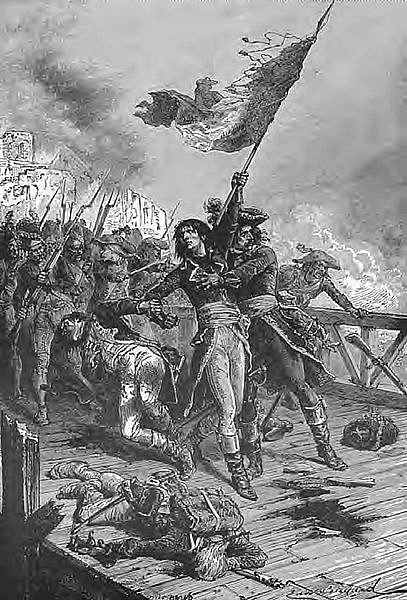
The charge barely made it onto the bridge when it petered out, bogged down by the relentless Austrian fire. As Bonaparte tried to spur his men to action, several of the officers surrounding him were hit, and one of his aides-de-camp, Colonel Jean-Baptiste Muiron, was killed at his side; at this point, an unknown French officer grabbed Bonaparte and pushed him into a muddy ditch in an attempt to save his life. As the French retreated from the bridge, the Austrians counterattacked, and a mud-covered Bonaparte had to be dragged to safety by his remaining aides-de-camp. Just before nightfall, General Guieu, who had finally found a crossing, arrived in Arcole and scattered the Austrian defenders. But this success came about six hours too late; most of Alvinczi's army had moved to Villanova, crushing Bonaparte's hopes of surprising him there.
Arcole: Days 2 & 3
Around midnight on 16 November, Bonaparte received word that Davidovich had defeated Vaubois and was currently marching toward him; to create a better defensive position, Bonaparte made the painful, yet prudent, decision to pull his men out of Arcole and Porcile. By the time he realized Davidovich was not coming, the Austrians had reoccupied both locations, and Bonaparte had to fight for them all over again. Throughout the day, bitter fighting took place all along the Alpone. The French eventually managed to win back Porcile but failed to take the bridge at Arcole and were hurled back from the mouth of the Alpone, which they had tried to ford.
By nightfall, although Alvinczi still controlled Arcole, his situation had become more precarious; he had sustained severe casualties and had lost contact with a third of his army, which was busy fighting General Masséna's division in the marshes. Alvinczi wrote to Davidovich to inform him that he would only be able to beat back one more French attack. That evening, Bonaparte was reinforced by 3,000 men from Mantua, giving him a numerical advantage over each enemy wing. During the night, the French engineers constructed a pontoon bridge at the mouth of the Alpone, which Augereau's division crossed over early on the morning of 17 November.
Augereau's men battled their way along the eastern banks toward Arcole while two demibrigades from Masséna's division, led by Brigadier General Jean-Gilles-André Robert attacked the western dykes. Meanwhile, Alvinczi began funneling more men into Arcole itself, where the fiercest fighting lasted throughout the day. At around 3 p.m., the Austrians charged out of Arcole and attacked Robert's force; General Robert was mortally wounded and his men were driven back. Augereau's division, which had just approached Arcole, witnessed this and began to waver.
Just when all hope seemed lost, General Masséna arrived with his division. Leaving a single brigade exposed on the Arcole and Porcile roads, he concealed the rest of his division in the willows and dykes; the Austrian garrison of Arcole fell for the trap and sallied out to attack the exposed brigade. It was at this moment that Masséna gave the signal and pounced on the garrison. The surprised Austrians were easily cut down and scattered after suffering heavy losses. Augereau's division, reinforced by cavalry from Legnago, returned to the fight, and together Masséna and Augereau entered Arcole after 5 p.m. Realizing his army was in a terrible position, Alvinczi ordered his whole army to retreat toward Vicenza overnight; on the morning of 18 November, French patrols found the Austrian camps deserted.
Aftermath
The three-day Battle of Arcole resulted in a resounding French victory. Despite initial setbacks, the French succeeded in preventing Alvinczi from reaching Verona or linking with Davidovich, albeit at a steep price; the French lost 1,200 killed including eight generals, 2,300 wounded, and 1,300 captured or missing. Austrian battlefield casualties were less significant, with 2,200 killed or wounded, but the French compensated for this by capturing 4,000 Austrian soldiers and 11 cannons. It was certainly a hard-fought battle, a fact recognized by Bonaparte himself, who would remark, "It took good luck to defeat Alvinczi" (Roberts, 123).
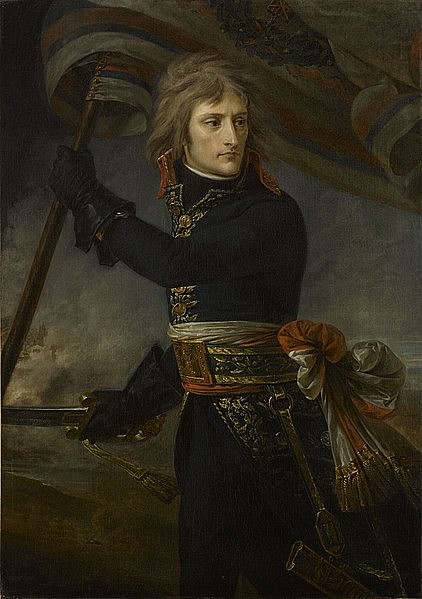
As it happened, the Battle of Arcole had ended in the nick of time; on 17 November, Davidovich had finally engaged Vaubois at Rivoli and had driven the French back. Bonaparte sent his cavalry to watch Alvinczi's movements and raced the rest of his army north to Vaubois's aid. He caught up with Davidovich at Rivoli on 21 November and engaged in a brief skirmish before Davidovich slipped away toward Trento; during the retreat, Davidovich lost 1,500 prisoners, nine cannons, and most of his supplies. When Alvinczi learned of Davidovich's retreat, he abandoned the plan to reach Mantua and began an orderly retreat toward the Brenta River to regroup.
The Battle of Arcole marked the end of the third Austrian attempt to relieve the siege of Mantua. A fourth and final attempt would be made the following January but would be thwarted at the Battle of Rivoli (14-15 January 1797). Wurmser held out until 2 February when he surrendered Mantua to Bonaparte; two months after that, Austria sued for an armistice, ending both Napoleon's Italian Campaign and the broader War of the First Coalition. Arcole was a decisive battle not only in the course of the campaign itself but also for the Napoleonic legend; one of Bonaparte's most impressive battles yet, Arcole would long be remembered as a great Napoleonic victory that helped shape the course of his career.
